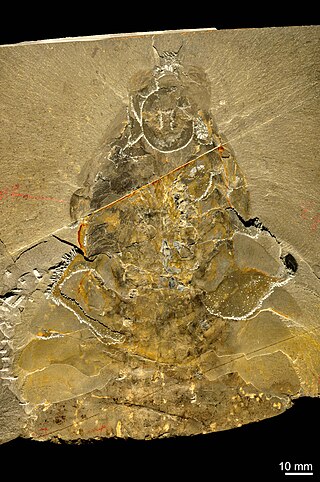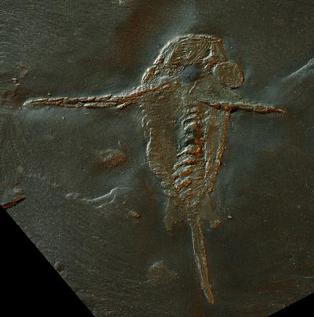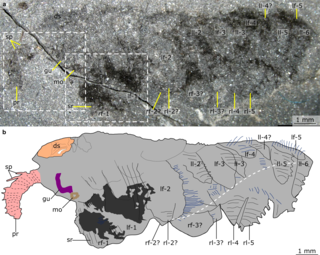
Yohoia is an extinct genus of megacheiran arthropod from the Cambrian period that has been found as fossils in the Burgess Shale formation of British Columbia, Canada. The type species, Yohoia tenuis, was described in 1912 by Walcott, who considered it an anostracan crustacean. 711 specimens of Yohoia are known from the Greater Phyllopod bed, where they comprise 1.35% of the community. In 2015, Conway Morris et al. reported another species, Y. utahana, from the Marjum Formation, Utah.

Anomalocaris is an extinct genus of radiodont, an order of early-diverging stem-group arthropods.

Peytoia is a genus of hurdiid radiodont, an early diverging order of stem-group arthropods, that lived in the Cambrian period, containing two species, Peytoia nathorsti from the Miaolingian of Canada and Peytoia infercambriensis from Poland, dating to Cambrian Stage 3. Its two frontal appendages had long bristle-like spines, it had no fan tail, and its short stalked eyes were behind its large head.

Amplectobelua is an extinct genus of late Early Cambrian amplectobeluid radiodont, a group of stem arthropods that mostly lived as free-swimming predators during the first half of the Paleozoic Era.

Schinderhannes bartelsi is a species of hurdiid radiodont (anomalocaridid) known from one specimen from the lower Devonian Hunsrück Slates. Its discovery was astonishing because previously, radiodonts were known only from exceptionally well-preserved fossil beds (Lagerstätten) from the Cambrian, 100 million years earlier.

Radiodonta is an extinct order of stem-group arthropods that was successful worldwide during the Cambrian period. They may be referred to as radiodonts, radiodontans, radiodontids, anomalocarids, or anomalocaridids, although the last two originally refer to the family Anomalocarididae, which previously included all species of this order but is now restricted to only a few species. Radiodonts are distinguished by their distinctive frontal appendages, which are morphologically diverse and used for a variety of functions. Radiodonts included the earliest large predators known, but they also included sediment sifters and filter feeders. Some of the most famous species of radiodonts are the Cambrian taxa Anomalocaris canadensis, Hurdia victoria, Peytoia nathorsti, Titanokorys gainessii, Cambroraster falcatus and Amplectobelua symbrachiata, the Ordovician Aegirocassis benmoulai and the Devonian Schinderhannes bartelsi.

Hurdia is an extinct genus of hurdiid radiodont that lived 505 million years ago during the Cambrian Period. Fossils have been found in North America, China and the Czech Republic.

Stanleycaris is an extinct, monotypic genus of hurdiid radiodont from the middle Cambrian (Miaolingian). The type species is Stanleycaris hirpex. Stanleycaris was described from the Stephen Formation near the Stanley Glacier and Burgess Shale locality of Canada, as well as Wheeler Formation of United States. The genus was characterized by the rake-like frontal appendages with robust inner spines.

Caryosyntrips ("nutcracker") is an extinct genus of stem-arthropod which known from Canada, United States and Spain during the middle Cambrian.

Aegirocassis is an extinct genus of giant radiodont arthropod belonging to the family Hurdiidae that lived 480 million years ago during the early Ordovician in the Fezouata Formation of Morocco. It is known by a single species, Aegirocassis benmoulai. Van Roy initiated scientific study of the fossil, the earliest known of a "giant" filter-feeder discovered to date. Aegirocassis is considered to have evolved from early predatory radiodonts. This animal is characterized by its long, forward facing head sclerite, and the endites on its frontal appendages that bore copious amounts of baleen-like auxiliary spines. This animal evolving filter-feeding traits was most likely a result of the Great Ordovician Biodiversification Event, when environmental changes caused a diversification of plankton, which in turn allowed for the evolution of new suspension feeding lifeforms. Alongside the closely related Pseudoangustidontus, an unnamed hurdiid from Wales, the middle Ordovician dinocaridid Mieridduryn, and the Devonian hurdiid Schinderhannes this radiodont is one of the few known dinocaridids known from post-Cambrian rocks.

Hurdiidae is an extinct cosmopolitan family of radiodonts, a group of stem-group arthropods, which lived during the Paleozoic Era. It is the most long-lived radiodont clade, lasting from the Cambrian period to the Devonian period.

Ramskoeldia is a genus of amplectobeluid radiodont described in 2018. It was the second genus of radiodont found to possess gnathobase-like structures and an atypical oral cone after Amplectobelua. It was discovered in the Chengjiang biota of China, the home of numerous radiodontids such as Amplectobelua and Lyrarapax.

Ursulinacaris is a genus of hurdiid radiodont from the Cambrian of North America. It contains one known species, Ursulinacaris grallae. It was described in 2019, based on fossils of the frontal appendages discovered in the 1990s and thereafter. The endites of Ursulinacaris were very slender, unlike other hurdiids such as Peytoia or Hurdia. It was initially reported as the first hurdiid with paired endites, but Moysiuk & Caron (2021) suggested that it is actually the preservation of the fossils and thus no paired endites.

Cambroraster is an extinct monotypic genus of hurdiid radiodont, dating to the middle Cambrian, and represented by the single formally described species Cambroraster falcatus. Hundreds of specimens were found in the Burgess Shale, and described in 2019. A large animal at up to 30 centimetres (12 in), it is characterized by a significantly enlarged horseshoe-shaped dorsal carapace (H-element), and presumably fed by sifting through the sediment with its well-developed tooth plates and short frontal appendages with hooked spines. Nicknamed the "spaceship" fossil when first found, for the way its dorsal carapace resembles the fictional Millennium Falcon, the specific epithet falcatus in its scientific name is a nod to that resemblance.

Houcaris is a possibly paraphyletic radiodont genus, tentatively assigned to either Amplectobeluidae, Anomalocarididae or Tamisiocarididae, known from Cambrian Series 2 of China and the United States. It contains two species, Houcaris saron and Houcaris magnabasis, both of which were originally named as species of the related genus Anomalocaris. The genus Houcaris was established for the two species in 2021 and honors Hou Xianguang, who had discovered and named the type species Anomalocaris saron in 1995 along with his colleagues Jan Bergström and Per E. Ahlberg.

Titanokorys is a genus of extinct hurdiid radiodont that existed during the mid Cambrian. It is the largest member of its family from the Cambrian, with a body length of 50 cm (20 in) long, making it one of the largest animals of the time. It bears a resemblance to the related genus Cambroraster. Fossils of T. gainesi were first found within Marble Canyon in 2018. The fossils were not named until 2021 because they were assumed to be giant specimens of Cambroraster.

Laminacaris is a genus of extinct stem-group arthropods (Radiodonta) that lived during the Cambrian period. It is monotypic with a single species Laminacaris chimera, the fossil of which was described from the Chengjiang biota of China in 2018. Around the same time, two specimens that were similar or of the same species were discovered at the Kinzers Formation in Pennsylvania, USA. The first specimens from China were three frontal appendages, without the other body parts.

Pahvantia is an extinct genus of hurdiid radiodont from the Cambrian. It is known by a single species, Pahvantia hastata, described from Wheeler Shale and Marjum Formation in Utah. Although it was once considered as filter feeder using large number of putative setae, this structures are later considered as misidentification of trunk materials.

Mieridduryn is a genus of extinct dinocaridid arthropod that lived during the Middle Ordovician of what is now the United Kingdom. This animal was described in 2022 based on a singular fossil found in Castle Bank, a Burgess shale type lagerstätte located in the country of Wales. This animal's taxonomic affinities are somewhat unclear, but there are some hypotheses. One is that this animal represents a new grade of stem-euarthropods that evolved features similar to the Cambrian aged opabiniids. Another is that if the features seen in Mieridduryn are convergent, and not homologous, to those seen in radiodonts, then this animal represents a late surviving opabiniid.

Cordaticaris is a genus of extinct hurdiid radiodont that lived in what is now northern China during the middle Cambrian period. This animal was described in 2020 based off remains found in the Zhangxia Formation, located in the Shandong Province. It is differentiated from other members of its family by its unique heart-shaped frontal sclerite, and its frontal appendages bearing nine endites and seven more elongated subequal endites. This animal was important as it was the first Miaolingian aged hurdiid known from rock layers outside of laurentia, allowing paleontologists to get a better grasp of this families geographic range in life.




















